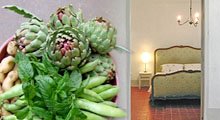 At the end of June, it's a purple patch that we go through. The lavender and perovskia are really going for it and they have been joined by the agapanthus now.
At the end of June, it's a purple patch that we go through. The lavender and perovskia are really going for it and they have been joined by the agapanthus now.
Tuesday, 30 June 2009
A Purple Patch
 At the end of June, it's a purple patch that we go through. The lavender and perovskia are really going for it and they have been joined by the agapanthus now.
At the end of June, it's a purple patch that we go through. The lavender and perovskia are really going for it and they have been joined by the agapanthus now.
Saturday, 27 June 2009
Thursday, 25 June 2009
Roussillon
 This is Roussillon in the Luberon. Until the beginning of the 20th century it was a centre of pigment mining. The pigments were used for paints of all kinds, and Rousillon is a good advertisement for its own product as all of the houses are rendered with various tints and shades of the local red rock.
This is Roussillon in the Luberon. Until the beginning of the 20th century it was a centre of pigment mining. The pigments were used for paints of all kinds, and Rousillon is a good advertisement for its own product as all of the houses are rendered with various tints and shades of the local red rock.
Les Sentiers des Ochres, Roussillon
 These cliffs are the old ochre works in Roussillon. In the 19th Century natural pigments were mined from these hills.
These cliffs are the old ochre works in Roussillon. In the 19th Century natural pigments were mined from these hills. The disused quarries, called "Les Sentiers des Ochres", are now open to the public. The circuit takes about an hour and a half.
Saturday, 13 June 2009
Gorges de la Nesque
 Yesterday we went walking in the Gorges de la Nesque. Here we are resting at the bottom of the cliffs that we'd just dropped down to along a steep, narrow and twisty track.
Yesterday we went walking in the Gorges de la Nesque. Here we are resting at the bottom of the cliffs that we'd just dropped down to along a steep, narrow and twisty track.
This is the Nesque itself, right down at the bottom of the gorge. In the height of summer, at this point it will completely submerge and only run underground through its gravel bed, which makes crossing easier.


... Lindsay and Ruth making the treacherous crossing!

 For more pictures of the Gorges de la Nesque, including the little 12th Century chapel at the bottom, look at our Picassa album for pictures that I took last year when I was there with a group of guests.
For more pictures of the Gorges de la Nesque, including the little 12th Century chapel at the bottom, look at our Picassa album for pictures that I took last year when I was there with a group of guests. Tuesday, 2 June 2009
Spiky Garden
 This is an allium christophii blooming in May in our Spiky Garden. I've just found that its common name is Star of Persia. I can see why. I, however, having forgotten the latin name over the last year, have been calling it the football flower because its large, spherical flower heads are almost as big as a football.
This is an allium christophii blooming in May in our Spiky Garden. I've just found that its common name is Star of Persia. I can see why. I, however, having forgotten the latin name over the last year, have been calling it the football flower because its large, spherical flower heads are almost as big as a football.
Just next to it is an Acanthus, also in bloom. Its tall, architectural spikes of flowers reach about 1m50 (5ft) in height. And along side them are two red hot pokers...

I reckon it's pretty obvious why I call it the spiky garden!
I've planted the spiky garden to surround one of our shady pergolas. Along with the acanthus, red hot pokers and alliums, I've mixed in several grasses, gladioli, agapanthus, rosemary and honeysuckle for year round interest.

At the moment, our antique iron day bed is under the pergola and the honeysuckle with its heady perfume is blooming too. All of which makes this an ideal spot to put your feet up and chill for a while...
Subscribe to:
Comments (Atom)

























